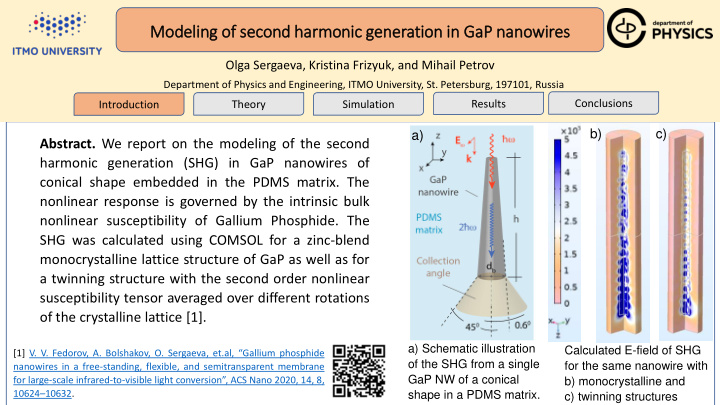



Mod odelin ing of of se second har armonic generation in in Ga GaP nan anowir ires Olga Sergaeva, Kristina Frizyuk, and Mihail Petrov Department of Physics and Engineering, ITMO University, St. Petersburg, 197101, Russia Conclusions Theory Simulation Results Introduction b) c) a) Abstract. We report on the modeling of the second harmonic generation (SHG) in GaP nanowires of conical shape embedded in the PDMS matrix. The nonlinear response is governed by the intrinsic bulk nonlinear susceptibility of Gallium Phosphide. The SHG was calculated using COMSOL for a zinc-blend monocrystalline lattice structure of GaP as well as for a twinning structure with the second order nonlinear susceptibility tensor averaged over different rotations of the crystalline lattice [1]. a) Schematic illustration Calculated E-field of SHG [1] V. V. Fedorov, A. Bolshakov, O. Sergaeva, et.al, “Gallium phosphide of the SHG from a single for the same nanowire with nanowires in a free-standing, flexible, and semitransparent membrane GaP NW of a conical for large-scale infrared-to-visible light conversion”, ACS Nano 2020, 14, 8, b) monocrystalline and 10624 – 10632. shape in a PDMS matrix. c) twinning structures
Mo Modelin ing g of of secon ond ha harmonic ic gen eneratio ion in n GaP GaP nan nanowir ires Olga Sergaeva, Kristina Frizyuk, and Mihail Petrov Conclusions Theory Simulation Results Introduction The second order induced nonlinear polarization: The polarization for the [100] structure: The polarization tensor for the [111] twinning structure: The polarization tensor for the averaged structure: [1] ACS Nano 2020, 14, 8, 10624 – 10632. [5] Phys. Rev. B 99, 075425 (2019).
Mo Modelin ing g of of secon ond ha harmonic ic gen eneratio ion in n GaP GaP nan nanowir ires Olga Sergaeva, Kristina Frizyuk, and Mihail Petrov Conclusions Theory Simulation Results Introduction We model [1] the second harmonic generation in 3 μ m-long GaP nanowires of conical shape with different diameters embedded in the PDMS matrix using COMSOL Multiphysics. Gallium Phosphide is a noncentrosymmetric material with second order nonlinear susceptibility 𝝍 (2) ~ 70 pm/V allowing bulk SHG; it has a high refractive index and broad transparency range [2-5]. The modeling includes the numerical simulation of the plane wave scattering at the fundamental wavelength followed by the simulation of SHG based on the calculation of induced by 𝝍 (2) second-order polarization [5]. For the SHG calculation, we utilize second order nonlinear susceptibility tensor 𝝍 (2) for a zinc-blend monocrystalline lattice structure of GaP as well as a twinning structure with the tensor 𝝍 (2) averaged over different rotations of the crystalline lattice. [1] V. V. Fedorov, A. Bolshakov, O. Sergaeva, et.al, “Gallium phosphide nanowires in a free-standing, flexible, and semitransparent membrane for large-scale infrared-to-visible light conversion”, ACS Nano 2020, 14, 8, 10624 – 10632. [2] L. Carletti, A. Locatelli, D. Neshev, and C. De Angelis, “Shaping the Radiation Pattern of Second-Harmonic Generation from AlGaAs Dielectric Nanoantennas ”, ACS Photonics 3 (8), 1500-1507 (2016). [3] R. Sanatinia, M. Swillo, S. Anand, “Surface Second-Harmonic Generation from Vertical GaP Nanopillars”, Nano Lett. 12 (2), 820 – 826 (2012). [4] J. Cambiasso, “Bridging the gap between dielectric nanophotonics and the visible regime with effectively lossless gallium phosphide antennas”, Nano Lett. 17 (2), 1219-1225 (2017). [5] K. Frizyuk, I. Volkovskaya, D. Smirnova, A. Poddubny, and M. Petrov, “Second -harmonic generation in Mie- resonant dielectric nanoparticles made of noncentrosymmetric materials”, Phys. Rev. B 99, 075425 (2019).
Modelin Mo ing g of of secon ond ha harmonic ic gen eneratio ion in n GaP GaP nan nanowir ires Olga Sergaeva, Kristina Frizyuk, and Mihail Petrov Conclusions Theory Simulation Results Introduction The second harmonic resonances correspond to the resonances at the fundamental wavelength, which (b) emerge due to the excitation and constructive interference of the Fabry-Perot modes propagating along the nanowire. Also, the SHG is modulated by the phase-matching conditions. Both monocrystalline and twinning structured (c) Gallium Phosphide single nanowires demonstrate high second harmonic generation efficiency (see Fig.). a) b) c) The arrays of such GaP nanowires embedded in PDMS a) Red line: calculated scattering Calculated E-field of membrane allow very efficient second harmonic efficiency for GaP nanowire tapered SHG for the same generation, which was explored experimentally [1]. with an angle of 0.6 ° , with bottom nanowire with diameter 100 nm, and height 3 μm b) monocrystalline and Blue and black lines: SHG efficiency for c) twinning structures [1] V. V. Fedorov, A. Bolshakov, O. Sergaeva, et. al, the same nanowire with monocrystalline and twinning structures ACS Nano 2020, 14, 8, 10624 – 10632.
Mo Modelin ing g of of secon ond ha harmonic ic gen eneratio ion in n GaP GaP nan nanowir ires Olga Sergaeva, Kristina Frizyuk, and Mihail Petrov Conclusions Theory Simulation Results Introduction We report on the efficient second-harmonic generation in a free-standing GaP nanowire array encapsulated in a PDMS membrane. Light coupling with optical resonances and field confinement in the nanowires together with high nonlinearity of GaP material yield a strong second-harmonic signal and efficient near-infrared (800-1200 nm) to visible upconversion. ACS Nano 2020, 14, 8, 10624 – 10632. Contacts E-mail: o.sergayeva@metalab.ifmo.ru ACS Nano 2020, 14, 8, 10624 – 10632.
Modelin Mo ing g of of secon ond ha harmonic ic gen eneratio ion in n GaP GaP nan nanowir ires Olga Sergaeva, Kristina Frizyuk, and Mihail Petrov Conclusions Theory Simulation Results Introduction Contacts ACS Nano 2020, 14, 8, 10624 – 10632. E-mail: o.sergayeva@metalab.ifmo.ru Aknowledgments The work is supported by the President of Russian Federation Grant No. МК -2360.2020.2. ACS Nano 2020, 14, 8, 10624 – 10632.
Recommend
More recommend